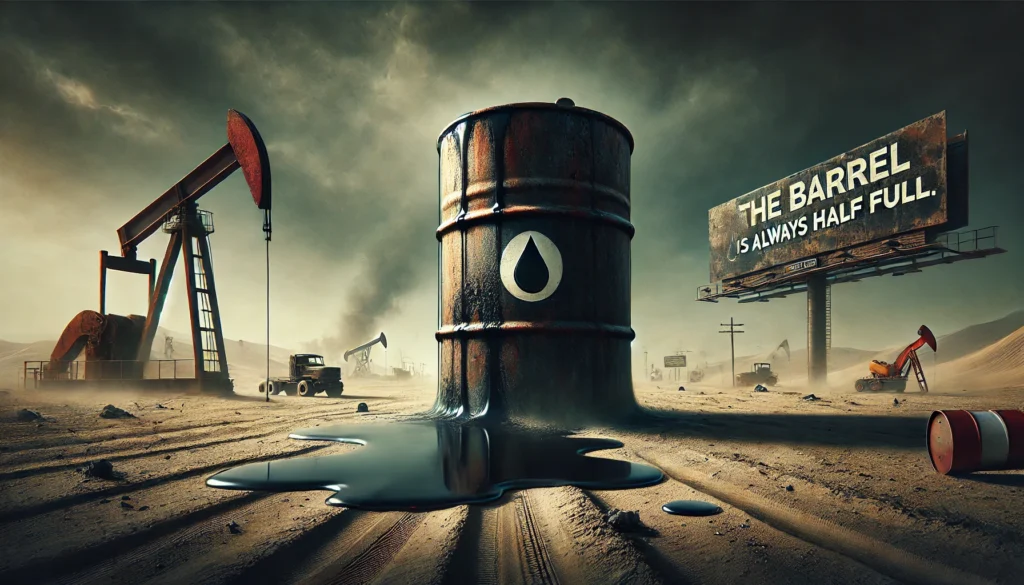Published Date: March 17, 2025 ✍️ Author: Global World Citizen News Team 📰 Source: GlobalWorldCitizen.com
The Oil Industry: Running on Half a Barrel
“Remember: The Barrel Is Always Half Full.” That’s the optimistic slogan displayed on a massive electronic billboard in Midland, Texas—the heart of the U.S. shale revolution. The message is clear: no matter the cycle of booms and busts, American oil producers should always look toward a brighter future.
But today, that spirit is hard to find. The industry overwhelmingly sees the barrel as half empty.
Diminishing Optimism in the Oil Sector
“There’s a lot less optimism,” said Scott Sheffield, a pioneer of the shale boom, during last week’s CERAWeek by S&P Global—an annual gathering of 10,000 energy executives, bankers, and traders in Houston.
Despite a favorable political climate, with Donald Trump’s return to the White House reviving the “drill, baby, drill” mantra and appointing Chris Wright, an oil industry insider, as Secretary of Energy, the mood at the event was unexpectedly subdued.
Publicly, industry leaders express enthusiasm about relaxed regulations, lower taxes, and the sidelining of climate change policies. However, in private conversations, executives voice deep concerns. Trump’s push for lower oil prices, coupled with the risk of a trade war-induced recession, looms large. A stark reminder came as Trump himself celebrated falling oil prices during a speech in Washington, sending an unmistakable message: the administration may not be as supportive as the industry hopes.
Oil Prices: Cheap by Historical Standards
Brent crude has tumbled nearly $30 per barrel over the past 18 months, as an influx of non-OPEC+ supply has overwhelmed steady demand growth.
In real terms, when adjusted for inflation, oil is currently cheaper than it was 25 years ago and even lower than prices during the 1991 Gulf War.
If OPEC+ sticks to its plan of gradual production increases until September 2026, the group could add over 2 million barrels per day—enough to meet all expected incremental demand through 2025 and 2026. But many OPEC+ members routinely exceed their quotas, flooding the market with even more oil than planned.
This oversupply puts immense pressure on non-OPEC+ producers, such as the U.S., Brazil, Guyana, Argentina, and Canada, who continue to increase production. However, lower prices could force some producers to slow down, preventing an outright market surplus. Adding to the uncertainty, China’s economic slowdown further dampens global demand.
The Oil Market’s Uncertain Future
The next two to three years present a critical question: What kind of cycle is the oil industry entering?
Recent OPEC+ production cuts and declining prices have shown that the cartel can no longer create a bull market simply by restricting supply. In fact, every time OPEC+ has tried to push prices above $80 per barrel, it has indirectly subsidized its competitors—strengthening non-OPEC+ producers.
For oil prices to remain sustainable, they likely need to fall below the $87-per-barrel average seen from January 2022 to December 2024. Otherwise, OPEC+ may be forced to cut supply even further.
A comparison to previous downturns suggests the industry is entering a moderate-price period, rather than a severe crash. During the last major oil bust from 2015 to 2017, crude averaged $51 per barrel. This time, a prolonged price collapse is less likely, as the era of runaway U.S. shale production is over. Instead, a few quarters—or possibly a couple of years—of moderate prices may be necessary to rebalance the market.
The only wildcard? Trump.
Sanctions on Iran could help artificially tighten supply, giving the industry a short-term boost. However, even this may not be enough if OPEC+ continues increasing production.
For now, the oil industry remains stuck over a half-empty barrel—uncertain of what comes next.


